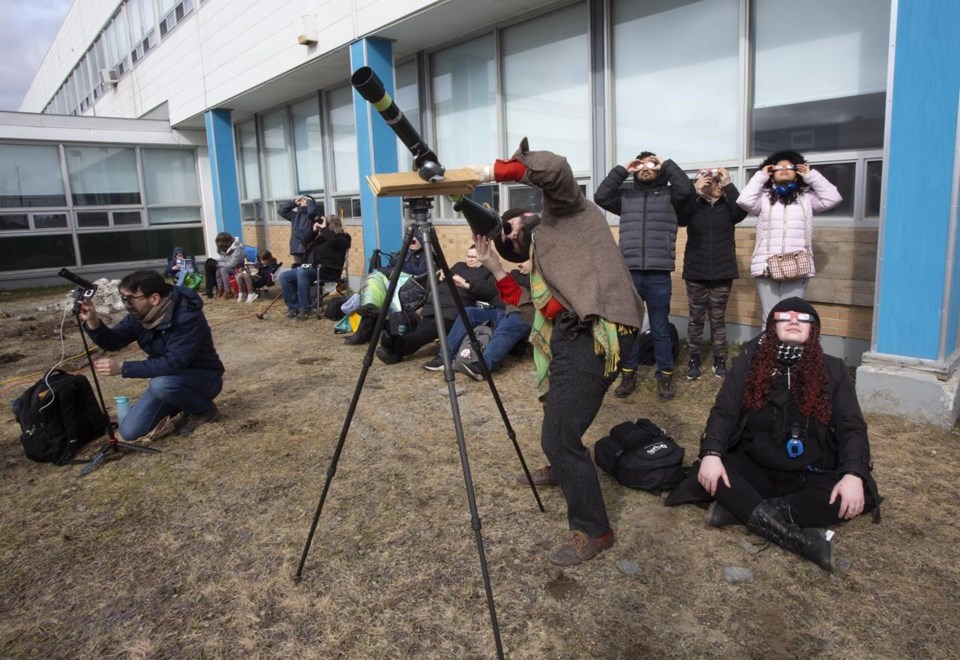GANDER, N.L. — An emotional astrophysicist struggled for words on Monday afternoon in Gander, N.L., after a total solar eclipse plunged the central Newfoundland community into darkness for more than two minutes.
Hilding Neilson said the spectacular astronomical event was particularly meaningful because it was visible in his home province, and he was able to share it with some of his students from Memorial University in St. John's.
“It was just remarkable, just an amazing experience,” Neilson said as the sun began to gradually reappear from behind the moon, and the sky lightened. “It was just amazing to see the darkness.”
Neilson was part of an eclipse-viewing party of more than 150 people at the College of the North Atlantic in Gander, which was in the path of totality — where the sun can be observed completely blocked by the moon, and the surrounding area is engulfed in nightfall. The crowd outside the college cheered loudly as the sun was blotted out and the sky and town was suddenly overtaken by night.
The temperature in the parking lot dropped noticeably as the sky darkened at around 5:10 p.m., and some people looked at each other with their mouths open, taken aback by how unmistakably, and how quickly, their surroundings had transformed.
Similar scenes took place across the Atlantic region, a good portion of which was in the path of totality.
In western Prince Edward Island, next to a lighthouse at the tip of North Cape, hundreds of people gathered at the edge of the red clay cliffs near the Wind Energy Interpretive Centre, normally closed at this time of year. The centre's parking lot, flanked by more than two dozen wind turbines, was packed with eclipse-chasers.
As the moon's darkest shadow descended on the area for more than three minutes, a chorus of oohs and ahhs could be heard, and many remarked about the orange glow on the horizon and the sudden drop in temperature along the darkened shoreline.
Kathy Eller of O’Leary, P.E.I., had no regrets after waiting outside for six hours to take in the total eclipse near the province’s northwestern tip. “It was better than fireworks,” she said. “It was spectacular … just the light and the colours and the sunset that was over there.”
Eller said it was an emotional experience when darkness descended.
“I forgot about everybody around, and was just concentrating on the sun and the moon. It was kind of like magic.”
In Fredericton, at the Bill Thorpe Walking Bridge, Sarah Reeve from Nova Scotia and Colleen Logan from Hampton, N.B., said they had tears in their eyes when they witnessed totality.
“We held hands and cried,” Logan said.
Reeve said she didn’t expect to feel the way she did, watching the skies darken and stars twinkle. They called the eclipse an immersive experience, and something they will never forget.
Back in Gander, 76-year-old Rick Young and his 60-year-old spouse, Cathy, took a totality selfie as the sun disappeared. The couple drove about four hours to get to Gander from Clarke's Beach to see the eclipse.
"It's just such a rare thing, a once-in-a-lifetime thing," Cathy Young said in wonder.
Newfoundland was the last spot in North America where people were able to view the total eclipse, the path of which travelled from the island's southwestern tip of Port aux Basques to the Bonavista Peninsula along the east coast.
Earlier in the day, at a local shop called Newfoundland Accents and Gifts, employee Pamela Inder said there were “lots and lots” of people in town for the day’s viewing event.
“It’s busy, there’s a lot of excitement,” Inder said after she rang up a few customers’ purchases. “That’s been the whole talk for the past week, everyone saying, ‘Are you going to watch it, do you have any glasses?’”
Earlier in the day, along Newfoundland's south coast, residents of a small fishing community prepared to celebrate their unique place in solar eclipse history.
Michael Ward, the town clerk manager for Burgeo, N.L., said British cartographer Capt. James Cook experienced a partial eclipse of the sun in 1766 on a small island just off the community's coast. Cook was so taken with the experience, he named the isle Eclipse Island, Ward said.
Nova Scotia, meanwhile, wasn't as lucky as the other parts of Atlantic Canada; the only spot in the province to view the totality was in the northern tip of Cape Breton, in Meat Cove.
And yet in Halifax, hundreds of people joined a long queue around Saint Mary’s University campus to get one of the 500 pairs of glasses handed out to those in line. The city didn't get totality — 94 per cent of the sun was covered by the moon — but student Anubhav Jain waited in line for more than two hours to get a set of eclipse glasses he shared with his friends.
“This is pretty exciting," he said. "It feels like a once-in-a lifetime event.”
This report by The Canadian Press was first published April 8, 2024.
— With files from Michael MacDonald in P.E.I., Hina Alam in Fredericton and Lyndsay Armstrong in Halifax.
Sarah Smellie, The Canadian Press



